Packaged foods company Kraft Heinz (NASDAQ:KHC) reported results in line with analysts' expectations in Q1 CY2024, with revenue down 1.2% year on year to $6.41 billion. It made a non-GAAP profit of $0.69 per share, improving from its profit of $0.68 per share in the same quarter last year.
Kraft Heinz (KHC) Q1 CY2024 Highlights:
- Revenue: $6.41 billion vs analyst estimates of $6.43 billion (small miss)
- EPS (non-GAAP): $0.69 vs analyst expectations of $0.69 (in line)
- Full year guidance reaffirmed for organic net sales growth and EPS (non-GAAP)
- Gross Margin (GAAP): 35%, up from 32.7% in the same quarter last year
- Free Cash Flow of $477 million, down 57.5% from the previous quarter
- Organic Revenue was down 0.5% year on year (slight beat)
- Sales Volumes were down 3.2% year on year (miss vs. expectations of down 2.8% year on year)
- Market Capitalization: $46.94 billion
The result of a 2015 mega-merger between Kraft and Heinz, Kraft Heinz (NASDAQ:KHC) is a packaged foods giant whose products span coffee to cheese to packaged meat.
Kraft was founded in 1903 as a business purchasing wholesale cheese and selling it to small stores in Chicago. The company revolutionized the dairy industry in 1916 when it patented a method for processing cheese that extended its shelf life, resulting in processed cheese. H.J. Heinz was founded in 1869 with horseradish as its first product. The company subsequently launched its tomato ketchup, which became known worldwide.
In addition to its namesake brands, the portfolio today features Oscar Meyer (hot dogs and other meats), Maxwell House (coffee), Velveeta (cheese), Philadelphia (cream cheese), and Capri Sun (juice), among many others. With these brands, Kraft Heinz caters to middle-income households seeking convenience. Customers who rely on these brands are usually busy and don’t have the time to cook meals or prepare snacks from scratch for themselves and their families.
Kraft Heinz products are sold by nearly every retailer that carries food, snacks, and drinks. The largest supermarkets to your corner deli or bodega will usually sell Kraft singles or Heinz ketchup. Given the company’s brand recognition and scale, Kraft Heinz often enjoys prominent placement on retailer shelves since their brands reliably drive foot traffic.
Shelf-Stable Food
As America industrialized and moved away from an agricultural economy, people faced more demands on their time. Packaged foods emerged as a solution offering convenience to the evolving American family, whether it be canned goods or snacks. Today, Americans seek brands that are high in quality, reliable, and reasonably priced. Furthermore, there's a growing emphasis on health-conscious and sustainable food options. Packaged food stocks are considered resilient investments. People always need to eat, so these companies can enjoy consistent demand as long as they stay on top of changing consumer preferences. The industry spans from multinational corporations to smaller specialized firms and is subject to food safety and labeling regulations.
Competitors in packaged food with diverse brand portfolios include Mondelez (NASDAQ:MDLZ), Campbell Soup (NYSE:CPB), General Mills (NYSE:GIS), and Nestle (SWX:NESN).Sales Growth
Kraft Heinz is one of the most widely recognized consumer staples companies in the world. Its influence over consumers gives it extremely high negotiating leverage with distributors, enabling it to pick and choose where it sells its products (a luxury many don't have).
As you can see below, the company's revenue was flat over the last three years as consumers bought slightly less of its products. We'll explore what this means in the "Volume Growth" section.
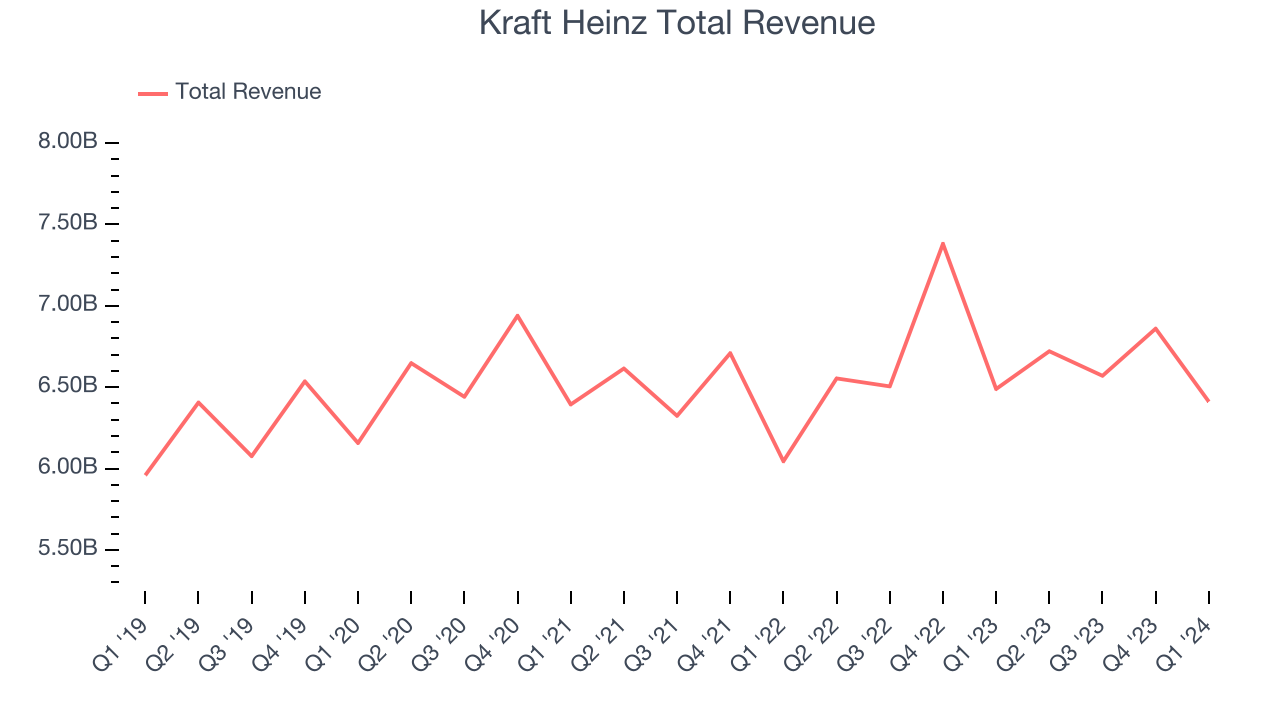
This quarter, Kraft Heinz missed Wall Street's estimates and reported a rather uninspiring 1.2% year-on-year revenue decline, generating $6.41 billion in revenue. Looking ahead, Wall Street expects sales to grow 1.6% over the next 12 months, an acceleration from this quarter.
Volume Growth
Revenue growth can be broken down into changes in price and volume (the number of units sold). While both are important, volume is the lifeblood of a successful staples business as there’s a ceiling to what consumers will pay for everyday goods; they can always trade down to non-branded products if the branded versions are too expensive.
To analyze whether Kraft Heinz generated its growth from changes in price or volume, we can compare its volume growth to its organic revenue growth, which excludes non-fundamental impacts on company financials like mergers and currency fluctuations.
Over the last two years, Kraft Heinz's average quarterly sales volumes have shrunk by 2.8%. This decrease isn't ideal as the quantity demanded for consumer staples products is typically stable. Luckily, Kraft Heinz was able to offset fewer customers purchasing its products by charging higher prices, enabling it to generate 5.7% average organic revenue growth. We hope the company can grow its volumes soon, however, as consistent price increases (on top of inflation) aren't sustainable over the long term unless the business is really really special.
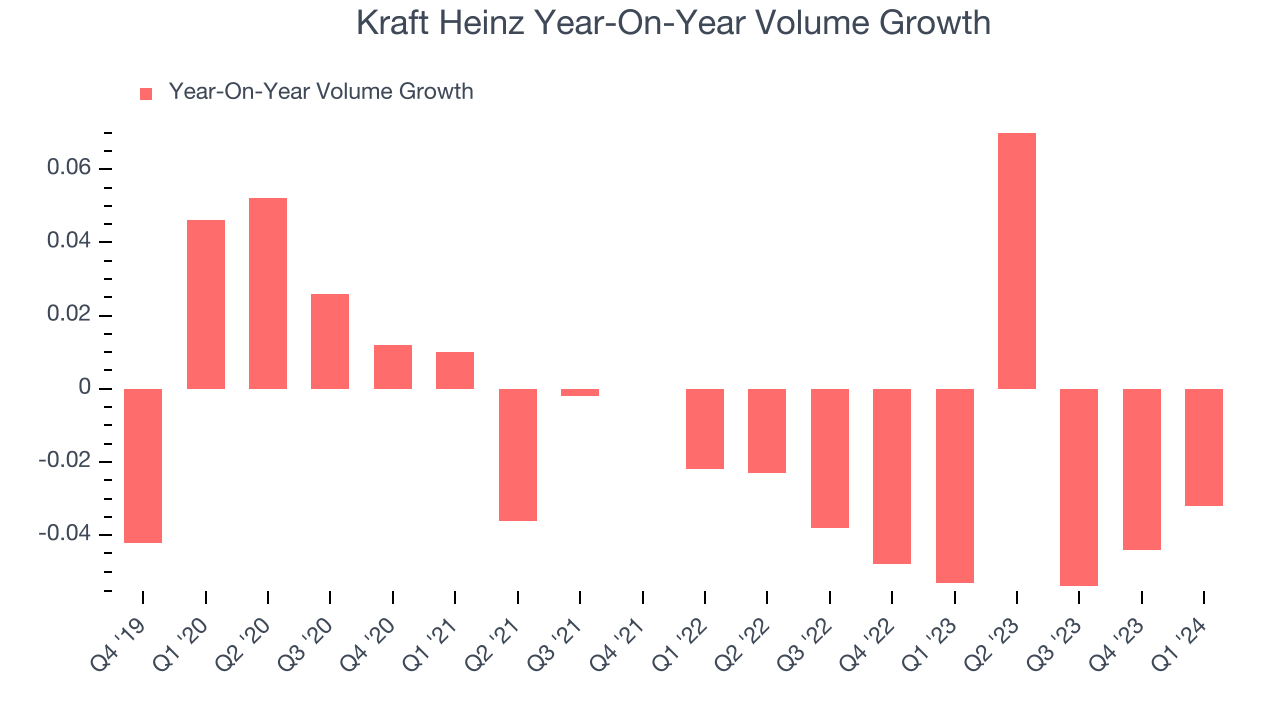
In Kraft Heinz's Q1 2024, sales volumes dropped 3.2% year on year. This result was a further deceleration from the 5.3% year-on-year decline it posted 12 months ago, showing the business is struggling to push its products.
Gross Margin & Pricing Power
This quarter, Kraft Heinz's gross profit margin was 35%, up 2.3 percentage points year on year. That means for every $1 in revenue, $0.65 went towards paying for raw materials, production of goods, and distribution expenses.
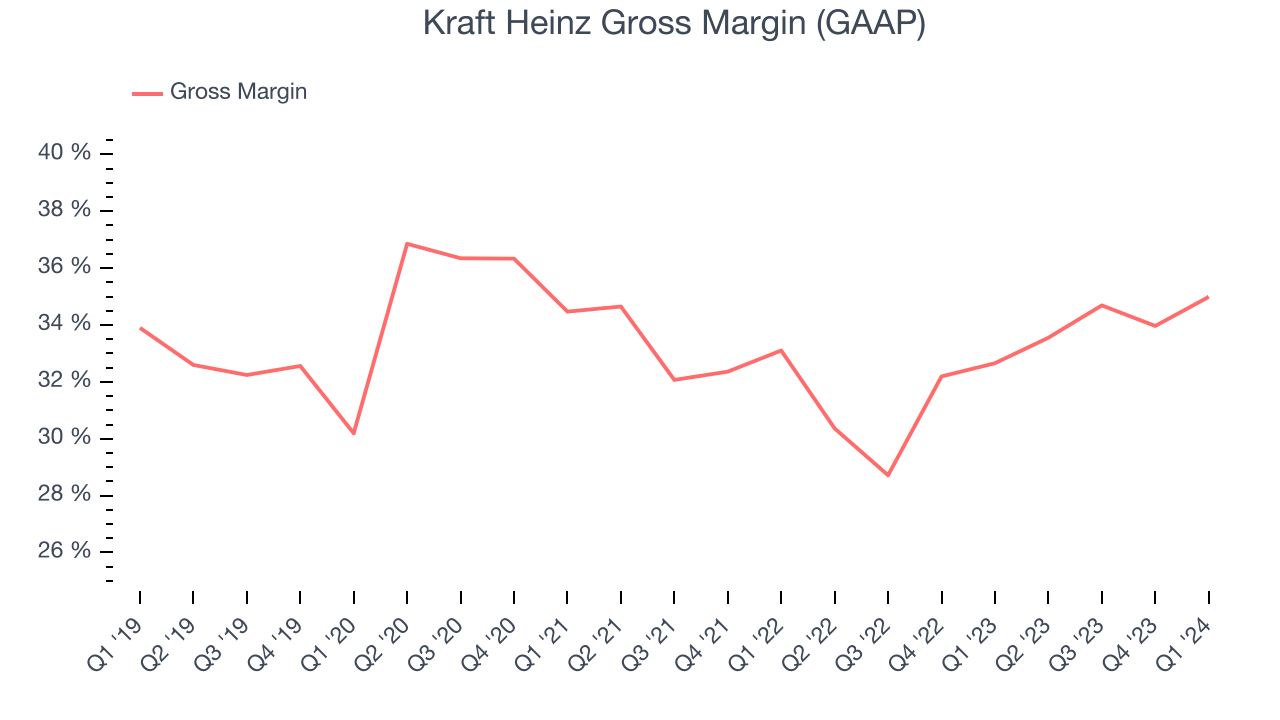
Kraft Heinz's unit economics are higher than the typical consumer staples company, giving it the flexibility to invest in areas such as marketing and talent to reach more consumers. As you can see above, it's averaged a decent 32.6% gross margin over the last eight quarters. Its margin has also been trending up over the last 12 months, averaging 11% year-on-year increases each quarter. If this trend continues, it could suggest a less competitive environment where the company has better pricing power and more favorable input costs (such as raw materials).
Operating Margin
Operating margin is a key profitability metric for companies because it accounts for all expenses enabling a business to operate smoothly, including marketing and advertising, IT systems, wages, and other administrative costs.
This quarter, Kraft Heinz generated an operating profit margin of 20.3%, up 1.2 percentage points year on year. This increase was solid and driven by stronger pricing power and lower raw materials/transportation costs, as indicated by the company's larger rise in gross margin.
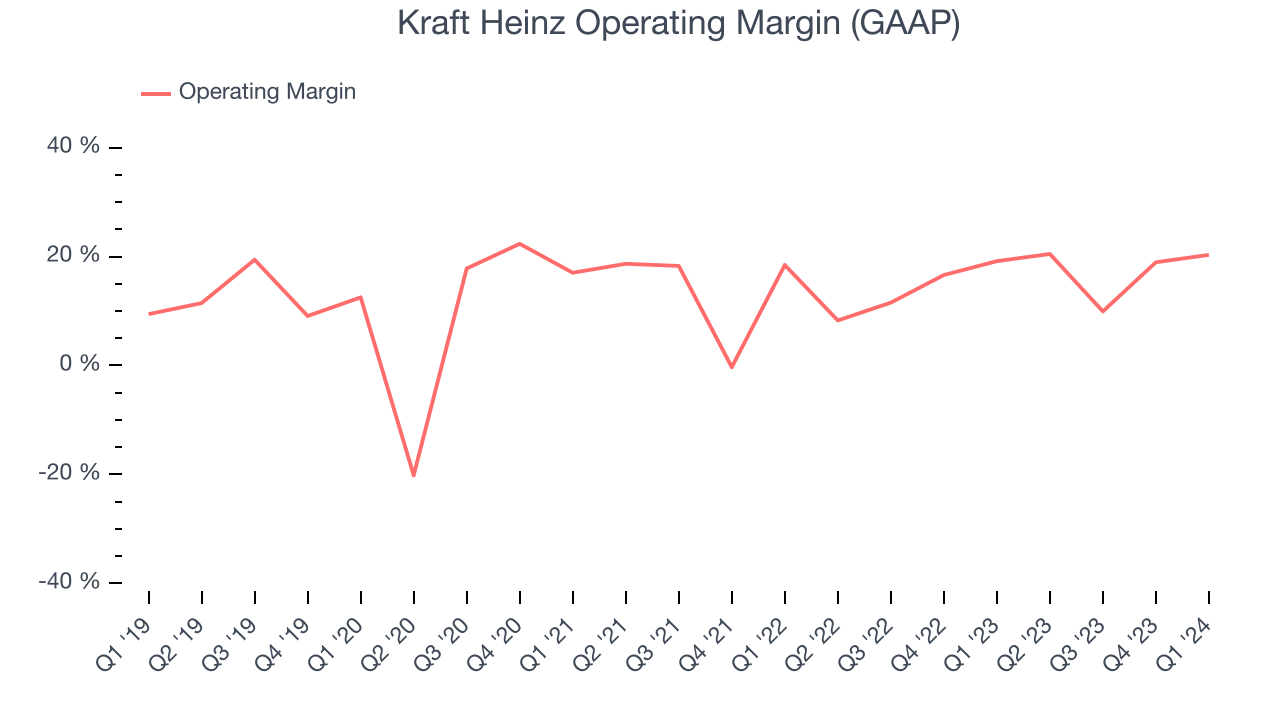 Zooming out, Kraft Heinz has managed its expenses well over the last two years. It's demonstrated solid profitability for a consumer staples business, producing an average operating margin of 15.7%. On top of that, its margin has improved by 3.5 percentage points on average over the last year, a great sign for shareholders.
Zooming out, Kraft Heinz has managed its expenses well over the last two years. It's demonstrated solid profitability for a consumer staples business, producing an average operating margin of 15.7%. On top of that, its margin has improved by 3.5 percentage points on average over the last year, a great sign for shareholders. EPS
These days, some companies issue new shares like there's no tomorrow. That's why we like to track earnings per share (EPS) because it accounts for shareholder dilution and share buybacks.
In Q1, Kraft Heinz reported EPS at $0.69, up from $0.68 in the same quarter a year ago. This print was close to Wall Street's estimates, meaning the result was likely already priced into the stock because investors were aware of expectations and traded accordingly.
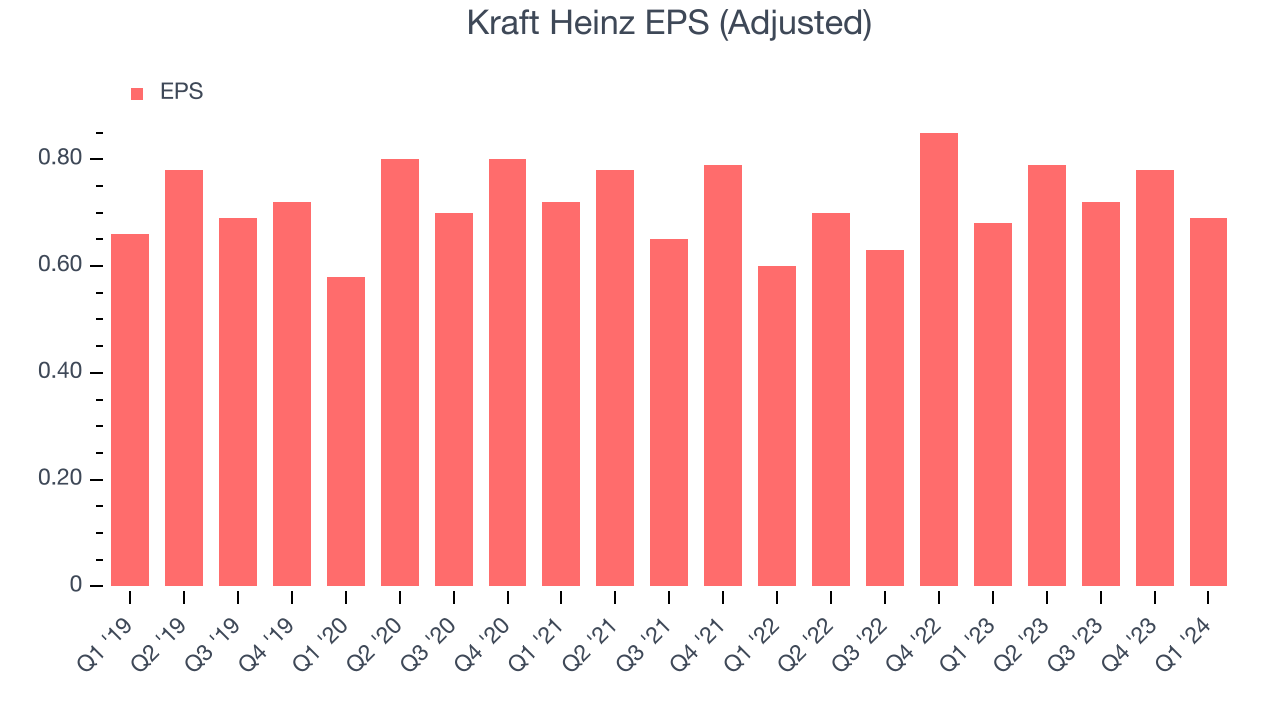
Between FY2021 and FY2024, Kraft Heinz's EPS dropped 1.3%, translating into 0.4% annualized declines. We tend to steer our readers away from companies with falling EPS, especially in the consumer staples sector, where shrinking earnings could imply changing secular trends or consumer preferences. If there's no earnings growth, it's difficult to build confidence in a business's underlying fundamentals, leaving a low margin of safety around the company's valuation (making the stock susceptible to large downward swings).
On the bright side, Wall Street expects the company's earnings to grow over the next 12 months, with analysts projecting an average 3.3% year-on-year increase in EPS.
Cash Is King
Although earnings are undoubtedly valuable for assessing company performance, we believe cash is king because you can't use accounting profits to pay the bills.
Kraft Heinz's free cash flow came in at $477 million in Q1, up 117% year on year. This result represents a 7.4% margin.
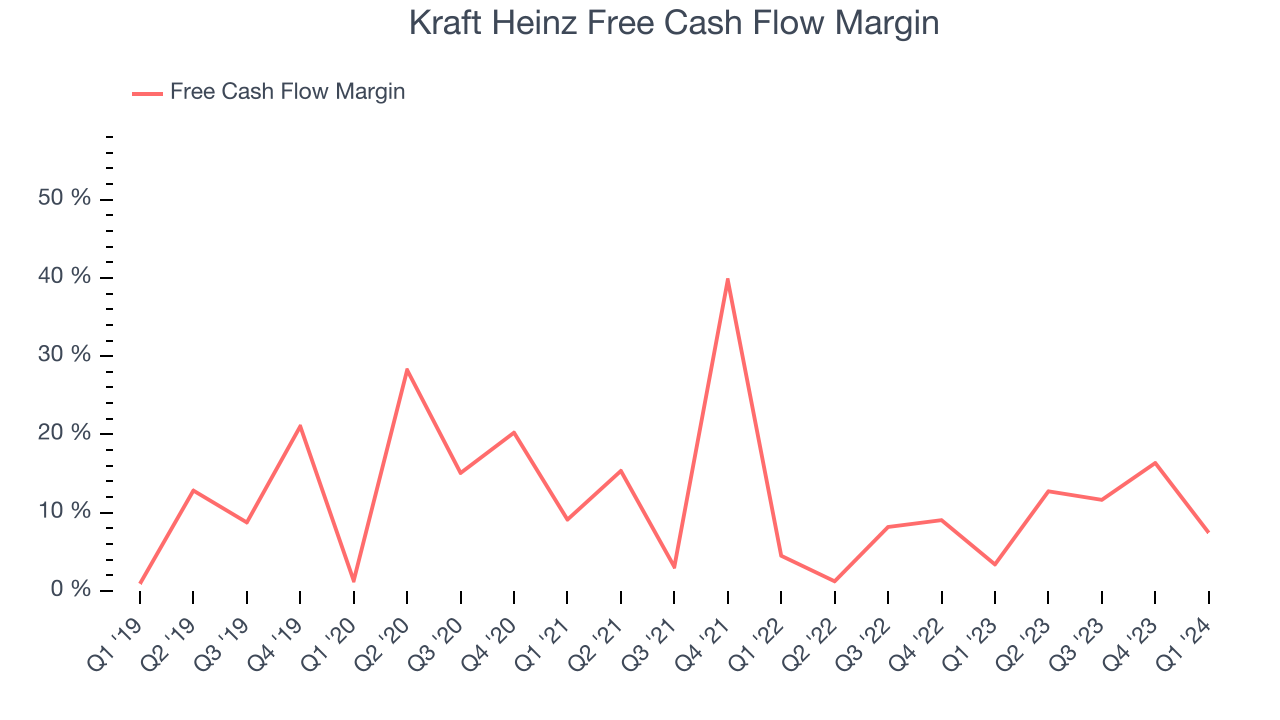
Over the last eight quarters, Kraft Heinz has shown solid cash profitability, giving it the flexibility to reinvest or return capital to investors. The company's free cash flow margin has averaged 8.8%, above the broader consumer staples sector. Furthermore, its margin has averaged year-on-year increases of 6.5 percentage points over the last 12 months. This likely pleases the company's investors.
Return on Invested Capital (ROIC)
EPS and free cash flow tell us whether a company was profitable while growing revenue. But was it capital-efficient? Enter ROIC, a metric showing how much operating profit a company generates relative to how much money the business raised (debt and equity).
Kraft Heinz's five-year average ROIC was 4%, somewhat low compared to the best consumer staples companies that consistently pump out 20%+. Its returns suggest it historically did a subpar job investing in profitable business initiatives.
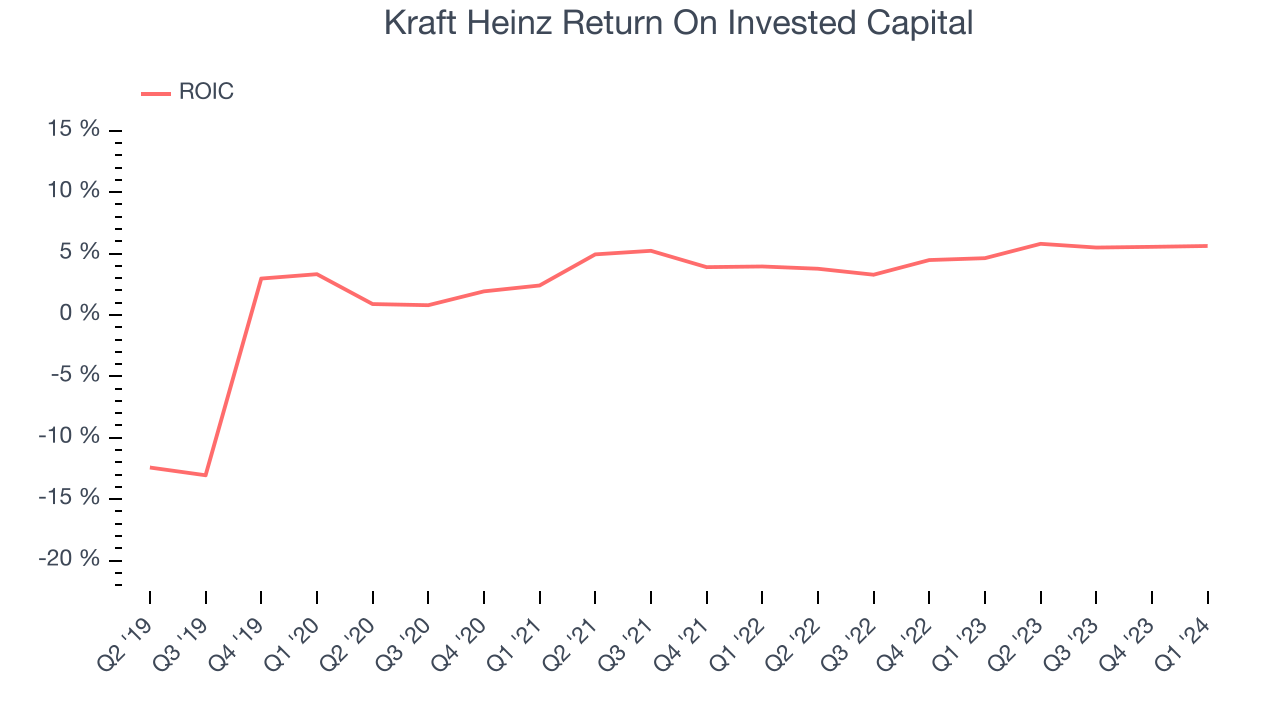
The trend in its ROIC, however, is often what surprises the market and drives the stock price. Over the last few years, Kraft Heinz's ROIC averaged 2.3 percentage point increases. This is a good sign, and we hope the company can continue improving.
Balance Sheet Risk
As long-term investors, the risk we care most about is the permanent loss of capital. This can happen when a company goes bankrupt or raises money from a disadvantaged position and is separate from short-term stock price volatility, which we are much less bothered by.
Kraft Heinz reported $1.63 billion of cash and $20.55 billion of debt on its balance sheet in the most recent quarter. As investors in high-quality companies, we primarily focus on two things: 1) that a company's debt level isn't too high and 2) that its interest payments are not excessively burdening the business.
With $6.36 billion of EBITDA over the last 12 months, we view Kraft Heinz's 3.0x net-debt-to-EBITDA ratio as safe. We also see its $425 million of annual interest expenses as appropriate. The company's profits give it plenty of breathing room, allowing it to continue investing in new initiatives.
Key Takeaways from Kraft Heinz's Q1 Results
We liked how Kraft Heinz exceeded analysts' organic revenue growth expectations this quarter, although volumes--the lifeblood of a staples business--continue to be weak. Operating profit was simply in line. The company maintained its previously-provided full year guidance, showing that things are on track with no major surprises. Overall, this quarter's results were unexciting. The stock is down 4.1% after reporting, trading at $37 per share.
Is Now The Time?
Kraft Heinz may have had a favorable quarter, but investors should also consider its valuation and business qualities when assessing the investment opportunity.
We cheer for all companies serving consumers, but in the case of Kraft Heinz, we'll be cheering from the sidelines. Its revenue growth has been weak over the last three years, but at least growth is expected to increase in the short term. And while its scale gives it immense negotiating leverage with retailers, the downside is its relatively low ROIC suggests it has struggled to grow profits historically. On top of that, its shrinking sales volumes suggest it'll need to change its strategy to succeed.
Kraft Heinz's price-to-earnings ratio based on the next 12 months is 12.5x. While there are some things to like about Kraft Heinz and its valuation is reasonable, we think there are better opportunities elsewhere in the market right now.
Wall Street analysts covering the company had a one-year price target of $40.49 per share right before these results (compared to the current share price of $37).
To get the best start with StockStory, check out our most recent stock picks, and then sign up to our earnings alerts by adding companies to your watchlist here. We typically have the quarterly earnings results analyzed within seconds of the data being released, and especially for companies reporting pre-market, this often gives investors the chance to react to the results before the market has fully absorbed the information.
